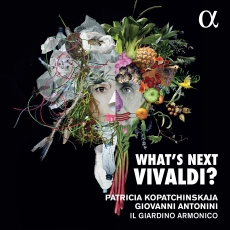Giovanni Antonini & Patricia Kopatchinskaja - What's Next Vivaldi? - Stereophile
Performance 5*
Sonics 4*
Forget almost everything you know about Vivaldi performance practice, authentic and otherwise, and shush all "shoulds." Banish from your mind any thoughts that all Vivaldi sounds the same. Prepare your ears to hear Vivaldi as you've never heard him before.
Blame what pours forth, if blame you must, on the astounding barefoot wonder, Moldovan-Austrian-Swiss violinist Patricia Kopatchinskaja. Using her copies of a Baroque-era Gagliano violin and bow to play like an altitude-defying mountain climber bounding from precipice to precipice, Kopatchinskaja knows nothing of caution as she propels five of Vivaldi's early 18th century Violin Concertos into our era. With Giovanni Antonini and his superb 15-member period instrument ensemble, Il Giardino Armonico, as equal daredevils, she does more than blow away close to four centuries of cobwebs. Kopatchinskaja approaches Vivaldi's music through a 2020 lens, determined to affirm his music's vital importance during an era when other concerns dominate the zeitgeist.
Yes, them's strong words. But What's Next Vivaldi?, which punctuates concertos by the master with contemporary compositions written mostly for the recording, makes a statement that's equally strong. The opening work, Vivaldi's Concerto in E-flat major, RV 253 La tempesta di mare, lives up to its name, with a tempestuous opening movement that's almost 20 seconds faster than Fabio Biondi and Europa Gallante's older and flatter-sounding recording for Erato; Biondi didn't engage in any of the extramusical effects that, on the new recording, may cause a thought bubble, as in "?!?!?!?!", to emerge, cartoonlike, from the top of your head.
RV 253's Largo is almost 30 seconds slower than Biondi's—that's a big difference in a concerto that lasts a bit more than 8 minutes—and it renders the interpretation more profound. The concluding Presto is nine seconds slower than Biondi's; that slight broadening allows its felicities to sink in deeper while daredevil Kopatchinskaja scales its peaks with soaringly sweet highs.
After La tempesta di mare, a 41-second quasi-spontaneous vocal free-for-all leads into Aureliano Cattaneo's energetic, short Estroso. All three expressions—the Vivaldi, the free-for-all, and the Cattaneo—seem curiously cut from the same cloth.
After the Cattaneo comes Vivaldi's RV 157 concerto, then Luca Francesconi's less-than-4-minute Spiccato il volo (The Violin Takes Off), which some might be inclined to accept as Vivaldi at his most extreme. Next up, Vivaldi's Concerto RV 191, with an astoundingly beautiful 4-minute middle-movement Largo whose execution epitomizes the paradox of constant movement within a framework of stillness. Then, Simone Movio's 4-minute Incanto XIX "seeks to synthesize the forms and structures of a Baroque concerto into a microarchitecture that allows us to glimpse its core under its outer envelope"—so say the liner notes—and composers Marco Stroppa and Giovanni Sollima offer other ways of using Vivaldi's music as springboards for contemporary musical exploration.
The last bit of Vivaldi on What's Next Vivaldi? is the Concerto for violin, strings and continuo in D major (Il Grosso Mogul) RV 208, which Rachel Podger and her smaller Brecon Baroque included on their superb 2017 Channel Classics DSD issue of The Four Seasons. Wonderful and authentic Podger's performance may be, but it's very much "in the box"—very English-polite compared to Kopatchinskaja and Antonini's radical interpretation (which uses Vivaldi's own cadenzas). The first movement on the new record sounds, at times, like a Venetian hoedown; you may even imagine you're hearing a banjo rather than a clavicembalo (aka harpsichord). Several extramusical effects seem intended to elicit an emotional response similar to that which led Johann Friedrich von Uffenbach to write, upon attending a performance that included one of Vivaldi's cadenzas, "[it] really frightened me, because something like that has never been played by anyone, nor can be ever played; for his fingers came only a straw's breadth from the bridge, so that the bow had almost no room, and this on all four strings with imitations [Fugen] and at unbelievable speed; he astounded everyone."
Coming at the recording's end, Béla Bartók's extremely short Szól a Duda (The Bagpipe) seems an organic extension of Vivaldi's wild Il Grosso Mogul.
As on many of Alpha's high-resolution efforts, the excellent engineering maximizes air and the sense of acoustic space. It sounds great in hi-rez, albeit not as arresting as Jared Sacks's superb work for Podger or John Atkinson's for the Portland State Chamber Choir. The recording includes naturally occurring instrumental squeaks and stage noises, as befits Kopatchinskaja's edge-of-the-precipice playing



